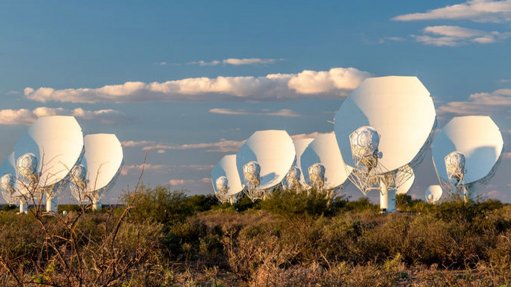
Precursor to the SKA: a recent photo of part of South Africa’s 64-dish MeerKAT radio telescope array, which falls under SARAO
Photo by: South African Radio Astronomy Observatory
The South African Radio Astronomy Observatory (SARAO) announced on Friday that the Square Kilometre Array (SKA) Telescope Manager (TM) Critical Design Review (CDR) had been completed. (The TM is a system, not a person.) The SKA is an international project to build the world’s biggest radio telescope, to be co-hosted by South Africa and Australia – with the addition of outstations in other countries during Phase 2 of the project.
The TM CDR was carried out by a consortium of nine institutions in seven countries, with SARAO making a significant contribution to it. Within the consortium, SARAO led the Telescope Manager System Engineering team and also participated in the Management work package. The South Africans who worked in the TM consortium were SARAO Software Functional Manager Ray Brederode, and SARAO Software team members Paul Swart, Lize van der Heever and Gerhard le Roux.
The TM consortium (formed in 2013) was one of 12 engineering consortia, involving 500 engineers in 20 countries, working on different aspects of the SKA. Nine of these consortia were concerned with critical components for the telescope and three were concerned with developing advanced instrumentation for it. The TM consortium was the first of all the consortia to pass the very thorough CDR.
“We are proud that the MeerKAT CAM [Control and Monitoring] system was selected as the reference design for [the] TM,” highlighted SARAO MD Dr Rob Adam. “South Africa can be very proud of its contribution to the SKA Telescope Manager design, proving that we have world class engineers able to work on complex problems, like designing the world’s largest radio telescope,” stressed Brederode.
With the successful achievement of the CDR, the TM consortium formally ceased to exist. However, SARAO and the other institutions which made up the consortium will continue to work with the SKO Organisation (the UK-based international body implementing the SKA programme) on the System Design and the construction proposal for the SKA. Their expertise will be necessary to make certain that the system design works together with the other elements of the telescope.
The other countries that participated in the TM consortium were Australia, Canada, India, Italy, Portugal and the UK. The consortium was chaired by the Dean of India’s Giant Metrewave Radio Telescope, Professor Yashwant Gupta.